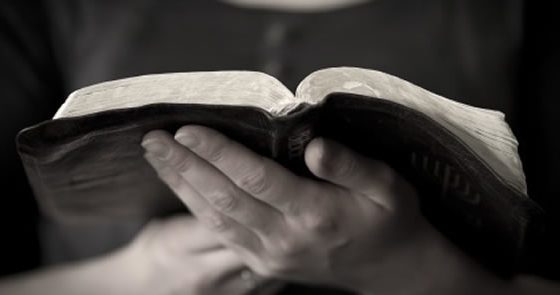This is a scientific world. We look at things according to the preponderance of facts. So if we look at data and it looks like something has occurred that may be miraculous, we’ve got to put the miraculous question on the back burner and at first just ask the historical question: What happened with the Resurrection? We don’t have to decide right now if God raised Jesus, but I think the way to start is to say, “What happened in time and space? Was there a man named Jesus? Did He die on a cross? And did His Disciples see Him again?” Let’s not ask right now, “Is the Resurrection of Jesus an event caused by God?” This is not a question historians can help us answer. They will tell you they don’t have the tools to talk about miracles. But they do have the tools to say this man walked and talked in first century Palestine. Secondly, they have the tools to say He died on the cross, a victim of Roman crucifixion. They have the tools to say people believed they saw Him afterwards.
Can Miracles Happen? On the one hand I want to say miracles cannot be ruled out a priori. But on the other hand, I want to say, “Let’s first talk about what is good history and then we’ll ask the question, “Could any of these be miraculous?” I think what I’m getting here is that historians do not have a choice but to take a line of facts in the direction that the data point us. If history says Jesus is thus and so, we have to be open to looking at that.
Now, what I meant there about the Resurrection goes something like this: I want to know if a man named Jesus of Nazareth walked and talked on the earth about 25, 27, 28 A.D. Historians come in and say, “Oh, yes. Virtually nobody thinks that He didn’t live.” Rudolf Bultmann, by the way, said, “We are now at the mercy of those who doubt or deny that Jesus lived, walked, talked in history.” So, the historian steps in and says, “Yes, I’ve got data for that.”
How about, “He died”? “Well, that’s not problem. Most people die.” And historians say, “Let’s follow that path. Yes, it takes us to the cross. The Romans hung Jesus, they put Him on the cross, He died, and we can find that in history.”
Now, when you get to the Resurrection, people start getting a little nervous. But here’s the point I’m making: let’s not ask the question, “Did God intervene and pull Him out of the tomb?” Let’s ask a much easier question, “Jesus of Nazareth, who walked and talked in Palestine, who was believed to have been crucified on the cross, did anybody claim to have seen Him alive after the cross? Did people walk with Him, and talk to Him and touch Him?”
You know, C. S. Lewis says the miraculous part of an event is “the initial aspect where it enters history. But after that, everything else is very normal. For example, if Jesus multiplied loaves and fish for 5,000-plus people, once He did the miracle — the multiplication?everybody ate, everybody was full, and everybody got tired. That’s what happens after you eat, that’s what food does — the miracle is the multiplication, not the eating and all this.
With the Resurrection accounts, we want to ask a simple question: Was there a man named Jesus, did He die on the cross, and did people claim to see Him afterwards? If so, why? Those are certainly claims that historians can get their fingers on. We have data there.
Just the Historical Facts Now, the question here, obviously, is what kind of data do we have? What are the “facts”? Because some people are going to be screaming, saying, “There are no facts!” Evangelical Christians are going to look at the New Testament text and say, “Facts are all over the place. Every time I read and find one, that’s a fact, because I believe the Scriptures are inspired.” Others will say, “No. It’s only a book of ancient literature.” Now you have to ask the question, “Which are believable facts and which are not?”
Most scholars will give you a list of facts surrounding the events that Christians call the Gospel: the trial, the death, the burial, the resurrection of Jesus. I think there are at least twelve facts that critical scholars will admit. The vast majority of scholars will give you more than these, but there are at least twelve facts virtually every scholar will admit.
1. Jesus died by crucifixion.
2. He was buried. Nothing strange about these things. Most people die. Most people are buried.
3. His death caused the Disciples to despair and lose hope, believing His life had ended. What would you say if your best friend died very suddenly?
4. Now, I admit this one is not as widely held, but many scholars believe that the tomb in which Jesus was buried was discovered to be empty just a few days later.
5. The Disciples had experiences? [And I’ll say this the way that even the critics will be able to accept it, I think.] The Disciples had experiences that they believed were literal appearances of the risen Jesus. They thought Jesus appeared to them.
6. Because of these experiences the Disciples were transformed from doubters into bold proclaimers of His death and resurrection. They had been afraid of their own shadow, so to speak, and certainly afraid to identify themselves with Jesus.
7. This message was the center of preaching in the early Church. Remember what Paul said?”Of first importance”: death, burial, resurrection of Jesus.
8. This message was especially proclaimed in the environs of Jerusalem where Jesus had died and was buried just shortly before.
9. As a result of this preaching, the Church was born and it grew.
10. Sunday became the primary day of worship. And that’s significant for Jewish believers.
11. Jesus’ own brother James, who had been a skeptic, was converted to the faith when he also “believed” that he saw the resurrected Jesus.
12. A few years later, Paul was converted by an experience which he likewise “believed” to be the appearance of the risen Jesus.
What I’m saying is that with the exception of the empty tomb, virtually all critical scholars accept this list as historical, and most of them will even grant the empty tomb. You can check my book, The Historical Jesus, as well as books by others to find lists of critical scholars who accept all of these things.
Now, you might say, “Wait a minute. Twelve? That’s not bad, but can we cut this list down? Can we get some more skeptics involved by being even pickier in what data we take?
All right. I’ll arbitrarily reduce this list to say four, five, or six:
Jesus died due to crucifixion;
The Disciples had experiences that they believed were the appearance of the risen Jesus;
Their lives were transformed because of that; and
A man named Saul of Tarsus believed that he was converted to Jesus by an appearance, a personal appearance of the risen Jesus to him.
These are four tough facts that virtually anybody is going to give you. And I think that we can build a case for that central proclamation of the death and resurrection of Jesus based on just these four facts alone. We might add a couple of others in here:
The Resurrection is the center of early Christian preaching;
What do you do with a fellow like James, the brother of Jesus?a skeptic who comes to Christ?
The fact that the Resurrection of Christ was proclaimed very early.
Now, here’s my point. With these facts, and the data that modify these facts, that are admitted by all, we have enough of a basis to say that Jesus died and that He was raised again from the dead. You can take home the whole pie with just these facts.
With just those facts, I have the major refutations of the naturalistic theories — the stories that say, “Well, what if Jesus wasn’t raised? What if what really happened was ____ (fill in the blank)?” With just these half dozen facts, you can refute all those major alternative hypotheses. At the same time, we have the very best evidences for the Resurrection contained right in this list. And really, this list is shorter than almost any list of facts produced by critics. By that I mean that I’m really asking for less facts here than almost anybody would give me.
These facts, by the way, have two prerequisites. Not only are they admitted by virtually all critical scholars, but second, they are individually attested by other data. So for the person who comes along and says, “I’m not going to give you any of your four. I’m just going to be belligerent with you. I’m not going to give you anything,” then with that person you build from the ground up. You start with zero and you tell him the evidence for one, two, three, four, five, six. You give him the evidence for each one of these. But the conclusion is, these facts alone give the major refutations of the naturalistic theories, and secondly, they provide the major evidences for the Resurrection of Jesus.
Hallucination Theory Let me take a case in point here. Let’s take the hottest naturalistic theory in the nineteenth century. The hypothesis says that Jesus died, all right, but He didn’t really rise from the dead; the Disciples saw hallucinations. We know that hallucinations are out there — they do happen, so that’s it right here: they saw hallucinations.
Looking only at this list, notice, number one, the Disciples had experiences that they believed to be appearances of the risen Jesus. Paul said these experiences occurred in groups. Hallucinations are not contagious. They don’t occur in groups.
Second, hallucinations are fairly rare. When you’re talking about groups of people, you’ve got hardheaded Peter, softhearted Mary, and softhearted John. My point is, you’ve got different people, different times, and different places. Paul lists an individual here, an individual there; 500 out there. Jesus appears at different places. And it’s not likely — I’m being very conservative there — that all these people would be just in the right frame of mind to see hallucinations.
Further, the Disciples were transformed; they were changed by what they saw. Hallucinations don’t transform. In fact, a man who has done some research with hallucinations says that people give up on the hallucination when someone tells them: a.) These things don’t happen; and b.) We didn’t see them. That would apply to the Resurrection above all: a.) Dead men don’t rise; and b.) we didn’t see Him — unless, of course, they did. So the transformations show that they really believed what they taught.
And what about the Apostle Paul? He wouldn’t be in the fight frame of mind to see a hallucination. I mean, the man was walking to Damascus, he says, to carry out threats against believers. Now, does that man want to see the resurrected Jesus?
And then you’ve got James, Jesus’ brother, an insider. What would you think if your brother were getting this kind of attention around the world? And James says, “I don’t believe.” He’s a skeptic. And critics usually admit that. But is James in the right frame of mind to see hallucinations? I don’t think so.
The Facts are Important On a personal note, the reason I think these facts are so important — at least in my life — is because I spent ten years as a skeptic. I argued with Christians. I kept rejecting their factual bases. I kept saying, “You don’t have data for that. That’s in the Gospels. You don’t have data for this, you don’t have data for that.” I had studied religion at state university and I thought that way. Christians have a right to believe the Gospels and so on, but for those who reject that, we need just a small basis of fact to show that the naturalistic theories have failed and that Christ has been raised from the dead. And I think that’s what these half dozen facts do.
Basically, here’s what we’re doing. We’re playing the method the way the critics do, thinking the way they think, and even treating the Bible as no more than an ancient book of literature — I mean, how can the Bible be less than that? It’s ancient; it’s got pages in it; and there are words on the pages. That’s pretty basic. And even treating the Bible as an ancient book of literature you still come up with these core or minimal facts, as I call them. And on this basis alone, we can refute the naturalistic theories and argue that Jesus was raised from the dead.
Jesus Died Now, the first fact on our list is that Jesus died. Why do scholars today rarely question the death of Jesus? Why do the founders of the Jesus Seminar, for example, those who’ve written on the subject, such as John Dominic Crossan and Marcus Borg, say that the fact that Jesus died is the surest fact we have in His career? Because the data are so strong. What are some of those?
First of all, death by crucifixion is essentially death by asphyxiation. When you hang on a cross and the weight of your body pulls down on the intercostal pectoral and deltoid muscles around your lungs, you reach a state where, when the weight is dragging down on them, you can inhale, but you are increasingly unable to exhale until you reach a place of almost paralysis and you can’t exhale at all.
In the 1950s an experiment was done in West Germany where male volunteers were tied to a 2 x 4. These men lost consciousness at a maximum of 12 minutes. Now, on the cross you could push up, if only on the nails or whatever. And when you pushed up you relieved those muscles around your lungs. But when you sagged down on them again — because you can’t stay up there for long — you pulled down on the muscles, and in the low position on the cross, you would asphyxiate. The Roman historian did not have to have a degree in medicine: if the person is hanging low on the cross for any amount of time — let’s say, 30 minutes — he’s dead.
Second, we’re told that they stabbed Jesus in the chest and blood and water came out. Someone says, “Well, that’s in the Gospel of John and we’re not going to give that to you.” Let me tell you something. In the ancient crucifixion accounts, there are a number of accounts of a coup de grace, a crushing blow, that’s done at the end of crucifixion to end the account. We have an account of a man whose skull was crushed to finish the process; a man who was threatened with a bow and arrow. We have Jesus in the Gospel of John, where he was stabbed to make sure he was dead. And of course, we have what’s known as crurifragrium in Latin, the breaking of the ankles so the person cannot push back up again. In all these cases, here’s what the executioner is saying: You’re not getting down alive.
So reason number one: If you’re low on the cross, you’re dead — you’ve asphyxiated. Number two: Deathblow. In the case of Jesus we’re told that it was spear that went into the chest. In the Journal of the American Medical Association just about 15 years ago, we were told that Jesus’ death came from asphyxiation. The researchers, including a pathologist from Mayo Clinic, said that the spear entered His heart and the water came from the sack surrounding the heart called the pericardium. So Jesus was dead. But if He wasn’t, the deathblow would have done it.
Third reason. Now, this gets a little bit gory, but the third thing is called “sucking chest.” It’s a very well known medical phenomenon. If you’re stabbed through the upper thoracic area and it goes through the lung, if you’re alive, there will be a sucking sound that comes through that hole. And guess what, you don’t have to be a medical doctor to know that if you’re making that sound, you’re alive. So if He was stabbed in the chest and it didn’t go through the heart, that is, if He were still alive, you would know because of the sucking chest syndrome.
So these are some of the reasons to believe that crucifixion is lethal. Asphyxiation, heart wound, and if it only went through the chest you would have the sucking chest.
The Swoon Theory Now, having said these things, none of these are the historical reason, the chief reason, for believing that Jesus did not fake death. In 1935, a German liberal named David Strauss wrote a life of Jesus. He was so liberal that he was pensioned off from his very liberal university and told to just quit teaching because of his highly critical view of Jesus. But here’s what he says in criticizing those who believe that Jesus didn’t die. (By the way, that was the most popular theory up until 1835 — that Jesus didn’t die.)
Strauss said: Here’s the problem with the swoon theory: it’s basically self-contradictory. Jesus should have died on the cross. Don’t worry about it — He didn’t.
Should have died in the tomb. Don’t worry about it — He didn’t.
Wouldn’t have been able to roll the stone away. That took several men. He’d be rolling the stone uphill out of the little gully in front of the tomb. He was in a weak condition. Don’t worry about it — He rolled the stone away.
He then walked (how far? I don’t know, a quarter mile? Several blocks?) to where the Disciples were on feet that had been pierced by nails.
Then Strauss said if you think those are problems, they aren’t even the chief problem. Here’s the chief problem with saying Jesus didn’t die: He comes to the door where the Disciples are and knocks. When they come to the door, what’s He going to look like? He’s pale. He’s sweating. The side wound has opened up again. He’s hunched over. He’s not even washed His hair. Sweat and blood have caked His hair. He’s limping. And He says, ?Fellows, I told you I would rise again from the dead.'”
Strauss says, watch what happens here. He’s alive, yes. Raised, no. Here’s what they would do. “Peter, give Him your chair.” “Andrew, go get some water.” “John, go get a doctor.” They’d say, ?Thank the Lord, He was healed’ or ?He’s getting healed’ or ?He’s alive.’ But they wouldn’t say, ?Thank the Lord, He’s been raised.’ And don’t expect to see Phillip over in the corner saying, as the New Testament says, ?O boy! Someday I’m going to have a resurrection body just like His.’ No, thanks. I’ll keep the body I have. Let Jesus keep the body He has.'”
Now, that’s Strauss’ point. Here’s what “swoon” says, and we often miss this: alive, yes; raised, no. What’s the problem? If the Disciples don’t at least believe He’s raised, you have no cause for the New Testament Church; no cause for really preaching. They have to at least believe He’s been raised. The swoon theory doesn’t give that to you.
Then you’ve got many other problems. What do you do with Paul? What do you do with James? How were they convinced to join the crowd here? The conclusion assuredly is that Jesus died on the cross due to Roman crucifixion.
Now, what happens when we apply this to a book like Hugh Schonfield’s 1965 bestseller, The Passover Plot? Schonfield suggested that Jesus did not die on the cross. (By the way, a lot of people don’t remember this, but he said, “This is only a suggestion. I’m not saying this really happened.”) But he said, “What if Jesus didn’t die on the cross?” Well, he runs up against asphyxiation. He runs up against heart. He runs up against chest. He runs up against Strauss’ critique. And so the swoon theory in The Passover Plot was largely ignored by critics.
The point is, you can’t rule out this material in that manner. In fact, let me tell you this. Albert Schweitzer’s famous book on The Quest for the Historical Jesus lists no scholars who hold the swoon theory after 1840. Historically speaking, Strauss’ critique alone, if you pardon the pun, killed the swoon theory.
He Was Buried Now, for the believer for whom the death and resurrection of Jesus are crucially important (as Paul says “of first importance”) where do we go next?
Jesus died on the cross, as, by the way, even the Talmud tells us. And then we’re told, “He is buried.” Now, this is not questioned by a lot of people. It’s a pretty normal event: people who die are buried. But what is there to say in favor of the burial accounts as we learn of them in the New Testament?
First of all, although critics today are not so inclined to take the Gospels as they are to take Paul, let’s just make the comment that all four Gospels agree that the tomb where Jesus was buried was empty.
The critic responds, “I don’t like the Gospels.” But let’s point out that just because the critic doesn’t like the Gospels does not explain the Gospels away. What you need, number two, is evidence that He was buried somewhere else. And that’s the key: evidence that He was buried somewhere else. There are no takers, really, because there is no early evidence that He was buried anywhere else. And you can say, “Maybe this, maybe that,” but let’s ask the unbeliever for the same type of data the Christian is asked for: Where is your data to say that He wasn’t buried just like the Gospels said?
Number three. A lot of folks have made the point that it is difficult to explain why Joseph and Nicodemus are named in those burial stories unless they were the guys that did the burial. Why bring these names out of obscurity if they weren’t really the people? It makes sense of somebody who believes they are telling the right story.
Fourth, we have a few texts that were written very shortly after Jesus’ death, burial and resurrection. In First Corinthians 15 Paul relates what is called the triple hoti — and, and, and — argument: “He died for our sins according to the scriptures, and He was buried, and He was raised, and He appeared.” Now, follow that sequence. If somebody is dead, buried, raised, and appeared, the strong implication is, the One that went down is the One that came up. You’ve got Paul saying there was a burial. He goes further than that, but we’ll save that for a comment on the empty tomb. Another good argument is Acts 13:29. Acts is accepted by many critics. In verse 29 we are told that He was buried. So those are two early textual arguments.
So far we have the 1.) Gospels; 2.) no evidence the He was buried elsewhere; 3.) Joseph and Nicodemus; we’ve got 4.) 1 Corinthians 15 and Acts 13; and, lastly, 5.) Jerusalem was the last place you want to proclaim the burial if He has not been buried there, because that’s the only place in the world it could be refuted. They can grab the body and say, “No. He’s not here, He’s over here.” Jerusalem is the last place to make that claim. So there’s a half dozen arguments to believe that what the Gospels say about the burial and what Paul says about burial is indeed true.
The Empty Tomb Let’s move on to the next step. He died. He was buried. What happened in that tomb? Well, the Christian story says He was raised. But in between burial and raising we’re told the tomb was vacated. Jesus’ leaving left it empty. Is there any reason to believe that?
Again, one of the first points we want to say is, all four Gospels record the empty tomb. And here come the critics: “I told you, I don’t like the Gospels!” What do we have to back up those early Gospel stories of the empty tomb? Let me give you three big evidences right off the bat:
Number one, The earliest witnesses to the empty tomb are women. Why is that important? Because if you’re making up a story, putting the words back into the mouths of the earliest Christians some time later, don’t use women for your first witnesses. Why? In the first century women were not allowed to testify in a court of law. It was believed that women were not able to tell the truth, so they couldn’t testify. Now, why do you take people who can’t go on the witness stand? It would be like making your chief witnesses little children. Why do you say, “There they are. The tomb’s empty. The women saw Him” unless, in fact, the women found the empty tomb first?
Second reason: The Jews believed the tomb was empty. Now, there is a rule in evaluating history that says when your critic admits something, most likely it’s correct. If you can’t stand somebody and you say he’s this and that and this and that and this and that, but he is a brave person, chances are, he’s a brave person. The Disciples said the tomb was empty. Now, the Jewish leaders thought the Disciples stole the body, but nobody, virtually no reputable scholar, has held that theory for over 200 years, because liars don’t make martyrs; you can’t explain the Disciples’ transformation and their honest belief. If they stole the body and lied, you have no explanation for James; you have no explanation for Paul. So that explanation does not make a lot of sense. But what are you left with? If the Disciples stole the body, according to the Jews, but that theory doesn’t really work, what you have is an empty tomb. What it seems like is that the Jewish leaders are making up an explanation to explain a fact: the body is gone.
Third argument. You have that early text I gave you before — 1 Corinthians 15. And Paul’s sequence again, is: died for our sins, buried, raised, appeared. Now, when the same person dies, buried, rises, and appears, guess what? The body is not there. What’s gone down has come up. And in 1 Corinthians 15 you have an overt statement of the burial and you have a strong implication of the next step, the empty tomb.
We get those from other things in here, as well. Again, just like the burial. Jerusalem is the last place to proclaim the empty tomb because people could say, “Ah, boys, the tomb’s not empty” and they could take you right back there.
Acts 13:29 says He was buried and the tomb was empty. So here’s another half dozen arguments, but especially I like the women, I like the Jewish admittance of the empty tomb, and I like Paul’s creed in 1 Corinthians 15. That’s three real tough arguments that say, “You know, what the Gospels said, they have the ring of truth regarding the empty tomb.”
Jesus Is Seen Alive After His Crucifixion We come now to the appearances of Jesus, and this is the chief evidence, by far. The critical community is willing to admit that the Disciples really thought they saw the risen Jesus, and this is the best evidence for the Resurrection of all of them. Now, how do we get there?
Let me start with a portion of that story that virtually everyone will admit. Reginald Fuller says, “This is the indisputable fact in the New Testament: the Disciples at least believe they saw the risen Jesus.”
Why is that true? Let me give you some examples of people who willingly give up their life for a cause — an ardent Communist; somebody who jumps on a grenade; kamikaze pilots in World War II; Islamic suicide truck drivers; Jim Jones’ followers; David Koresh’s followers; or even the comet people who believe they are being taken away so they take the poison and lay down and die. What’s the key to each of these? We don’t understand a lot of these actions, but here’s what we can say: They believed what they died for. Nothing else explains it. They believed the UFO was coming. They believed there was a UFO behind the comet. They believed their country was worth dying for. They believed their philosophy, perhaps Communism, was worth dying for.
And it’s true of the Disciples. The only explanation is that they believed Jesus was raised from the dead. Rudolf Bultmann in his seminal 1940 essay, New Testament and Mythology, he said, “A secular historian can only say this: The earliest followers believed they saw the risen Jesus.” And I’m saying, if you have that fact, you’ve got the key one. Everything else flows from there to the appearances of Jesus.
Now, as I said, I imagine a lot of people are listening are saying, “I’ll grant you that. The Disciples believed they saw Jesus.” How do you get from “thought they saw” to “they saw”?
And let me say in a nutshell and let me give you an illustration of where I’m going. The fact that they thought they saw the risen Jesus is important for two reasons. Those half dozen facts I asked for and evidenced before, those facts tell me, number one, naturalistic theories don’t work. They believed they saw the risen Jesus. But some people say they saw hallucinations. We have already seen that, using only a half dozen facts, hallucinations don’t work.
So, on the one hand the Disciples thought they saw the risen Jesus. Critics make up “what ifs” scenarios — they don’t work. Naturalistic theories fail. But the second reason that “they believed they saw Jesus” turns into “they saw Jesus” is that those same half dozen facts that everybody admits includes a lot of good evidences that they really saw Him — their lives were changed; it was a central proclamation; how do you get Paul onboard? How do you get James onboard? Every one of them agreed it was something they saw.
The Kroger Experience Now, let me tell you a little story that might help to drive this home. What does Christianity have that none of these other religions have? Jim Jones’ followers believed he was the messiah. They were wrong. David Koresh, likewise. The Hale-Bopp comet people believed the UFO was coming for them. Anybody can be wrong about beliefs.
Let me tell you something that was different about the Disciples. They didn’t just say Jesus was the Messiah and He was raised from the dead. Their central claim was, “We saw Him.” Paul said, “If Christ has not been raised from the dead,” after just giving a list of the appearances (1 Corinthians 15), “then our faith is vain.”
Now, I liken this to a common experience, say, shopping at Kroger. If I went to Kroger last night and saw you there, I might remember a conversation we had, “Remember, we were talking about the spinach?” Now, what if a bunch of our buddies happened to be there as well, and we kept running into each other throughout the store. One time two of us saw you; on another aisle, just me; another time, there are five of us who saw you on the same aisle. And let’s just say for a parallel here, eleven or twelve different people saw you in Kroger’s last night. It would be pretty hard for you to claim, “No, you didn’t see me in Kroger last night,” especially if I have several of the guys with me who will say, “Oh, come on! We saw you in Kroger last night. Saw you alone, we saw you with two or three others, and a group of us saw you all at the same time.”
The Disciples were saying, “I believe Jesus’s claims that He is the Son of God. I believe God vindicated Him by raising Him. I believe He was raised.” Some of these claims don’t sound a lot different on the surface than what other people have believed. But the Disciples added something else: “I saw Him. I touched Him. When He appeared, I was shocked. But once He appeared,” the Gospels say, “He ate. He walked. He cooked a shore lunch.” I mean, He was doing normal things. And that’s the Kroger experience.
But what if I was at your funeral last week? What if I was at your funeral last week and tonight I saw you in Kroger, and all my buddies saw you in Kroger, too? How much evidence would it take to convince somebody that we saw you? The more the merrier. Two heads are better than one. We have all kinds of sayings for this. But the point is, I could be convinced of two things: I saw a body in the casket. I even reached over and touched you and you were dead. I saw you at Kroger, and I don’t know how to explain this, but it’s a pretty mundane event: I saw you picking up food. I saw you walking, I saw you talking.
My point is, the Disciples didn’t just say, “We believe Jesus,” they said, “We saw Jesus.” And somehow, we have to do justice to that “We saw you” point. And like C.S. Lewis says, it’s the Resurrection that is miraculous. The walking and talking and shore lunch and so on, those are normal events once you’ve been raised. And Kroger is a normal event. I saw you at your funeral last week; I see you in Kroger today. You know what? I’ll remember that for the rest of my life. And every time I doubt, I’ll go to my buddies and they say, “Hey, we’re there with you. We saw him there.”
I think that is what we’re dealing with. Yes, the Disciples believed; they believed Jesus was raised, they believed He is the Messiah. But besides that, they’ve got a punch here that nobody else has: “I saw you at Kroger” and “We saw you in a group.” If my faith is based on seeing you at Kroger, I think it’s pretty firm. And that’s one reason the Disciples were so excited and so convinced: “Seeing is believing.”
Paul and James Now, going back to our facts, what do we have here that indicates that Jesus was raised? We established that He died. Secondly, we have people who are saying, “I saw the risen Jesus.” Third, their lives were transformed because… not because of His teachings or some general euphoric feeling or whatever, but because they saw Him. Paul said of Christ, “if He has not been raised, our faith is vain.”
Fourth, you’ve got a person named Paul. He’s on his way to kill Christians. He’s not in the mood to see resurrected Jesuses around, and here, boom! Jesus is in front of him. Strikes him down. He’s blind, according to the Book of Acts. Paul says himself in 1 Corinthians twice, “I saw the risen Jesus.”
What do you do with James, the insider, the family skeptic? And he meets the risen Jesus.
The Evidence is In In each of these points the probabilities begin to go up. And the general rule — “Dead men don’t rise” — is looking less and less likely in this instance, only because it’s being outweighed by the facts.
We live based on probabilities all the time. At this point you have to make a decision: Is it really true? Is this evidence? Can I conclusion not just that it probably happened, but can you reach a point where the evidence says, “Wow! He was raised”?
I think you can. And what I’m suggesting is that that’s exactly what happened to the Disciples when they had evidence upon evidence, what Luke calls “many infallible proofs” in Acts 1:3.
Now, at just about this time I can picture an objection from the other side. Christians are saying, “This evidence is starting to look so good, but what about faith? I mean, facts don’t get us into the Kingdom of God.” But faith is not a leap into nothingness. In the New Testament, without exception, faith is based on trustworthy data. Paul says, back to 1 Corinthians 15, I came and I preached to you the message — at least three things that are always present in the New Testament definition of the Gospel — “deity of Christ, death, resurrection.” Paul said, “If you believe these things, you’re saved. You have eternal life.” In Christianity there’s always content. We call that the Gospel data: deity, death, and resurrection of Jesus.
But how do you get from Gospel data to salvation? There’s something missing. Facts plus faith equals salvation. But that’s not accurate enough. In the New Testament, it’s not facts in which we place our faith. I love history, but New Testament faith is not placed in history, it’s placed in the Jesus of history. Or if you prefer, to get real exact here, Jesus of the Gospel facts — deity, death, resurrection — plus faith = salvation.
Faith goes in the person of Jesus. You know, it’s sort of like marriage. I could be convinced that a woman is the best possible person for me. She’s good here, she’s good here, she’s good here. Everything. But you know, what? If I don’t say “I do,” we’re not married. I think that’s the New Testament picture. It’s an analogy but a decent New Testament picture of what faith in Jesus Christ is. We could be convinced that Jesus did this and He did this and He did this, and, oh yeah, He died for my sins, He was buried, He rose again from the dead. He’s even the Son of God. But in the New Testament, if I don’t say “I do,” if I don’t say “I trust Him,” if I don’t commit myself to Him, I’m not a Christian. And that, I think, is the key here as we’re coming down to what this means. The Jesus of the Gospel facts plus faith equals salvation — and I think that’s Paul’s argument in the first few verses of 1 Corinthians 15.
Now, if you’re sitting there wondering, “Look, I don’t know. I’m a Hindu. I’m a Buddhist. I’m an agnostic. I’m an atheist.” Sure, you can walk away and not believe in Jesus, but you know what? I don’t think you can walk away and say there’s no data. I don’t think you can walk away and say there are no facts. I really wonder if you want to try to shorten that list of six facts because we can argue to each one of them independently.
But do you know where all this is going? Paul says that it’s because of the Resurrection that death has no sting. It’s because of the Resurrection that the grave has no victory. Because of the Resurrection of Jesus we have a shot at eternal life. But we need to say, as Paul said, “I do” to Jesus. It’s all in whether we make that commitment. You know, you may believe someone is right to you. If you don’t say “I do,” you’re not married. If you don’t say “I do” to Jesus, what do you have? You still haven’t accepted His teachings. “O death, where is your sting? O grave, where is your victory?”
I leave you with the words of Jesus: “Because I live, ye shall live also.”
Copyright © 2006 John Ankerberg, used with permission.
Read more at johnankerberg.com
[Editor’s Note: This information is excerpted from the transcript of the series “Evidence for the Historical Jesus.” The entire series is available through our online catalog in VHS video, audio tape or written transcript formats.] [schemaapprating]










